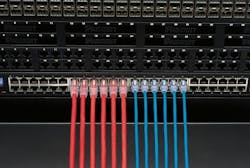The Telecommunications Industry Association’s TR-42.7 Telecommunications Copper Cabling Systems Subcommittee recently established a task group to study the characteristics of twisted-pair patch cords with 28-AWG conductors. The formation of a task group is a far cry from the development of a standard on any technology, but it is an initial step for projects that do become standards.
The current TIA standard governing twisted-pair copper cabling systems, TIA-568-C.2, includes the requirement: “Cord cable shall consist of four balanced twisted-pairs of 22 AWG to 26 AWG thermoplastic insulated solid or stranded conductors enclosed by a thermoplastic jacket.”
The higher the AWG number, the smaller the diameter of the conductor. So 28-AWG conductors are smaller than what the standard permits. If 28-AWG cords are used in channels, users can follow a de-rating method to determine the appropriate length (less than 100 meters) of the channel.
In an article we published in September 2015, titled “Applications for 28-AWG twisted-pair cabling systems,” Panduit senior product manager Thomas Baum explained, “TIA-5789-C specifies a maximum 100-meter length channel for copper cabling, which comprises 90 meters of permanent link cabling (typically solid cable) and a total of 10 meters of patch cabling. If you use 28-AWG patch cabling, you must adhere to a de-rating factor that reduces the maximum channel length achievable.”
He further explained by way of these examples: “If your goal is to maintain the 90-meter permanent link, a total of 6 meters of 28-AWG patch cord can be used, for a 96-meter channel length. If your goal is to maintain 10 meters of total patch length, then the maximum permanent-link length must be adjusted to 83 meters, for a maximum channel length of 93 meters. The shorter channel length is necessary because of the higher attenuation inherent in the 28-AWG cable’s smaller wires.”
Despite noncompliance with TIA standards, 28-AWG cords have been shown to provide certain benefits, many of which relate to cable management as well as the use of rack space and telecom-room space. Baum detailed several such benefits in his article.
The photo on this page shows a side-by-side size comparison of 24-AWG cords and 28-AWG cords.
We will track the progress of the task group within TR-42.7 and report on the possibility of their efforts resulting in the development of a standard document.
